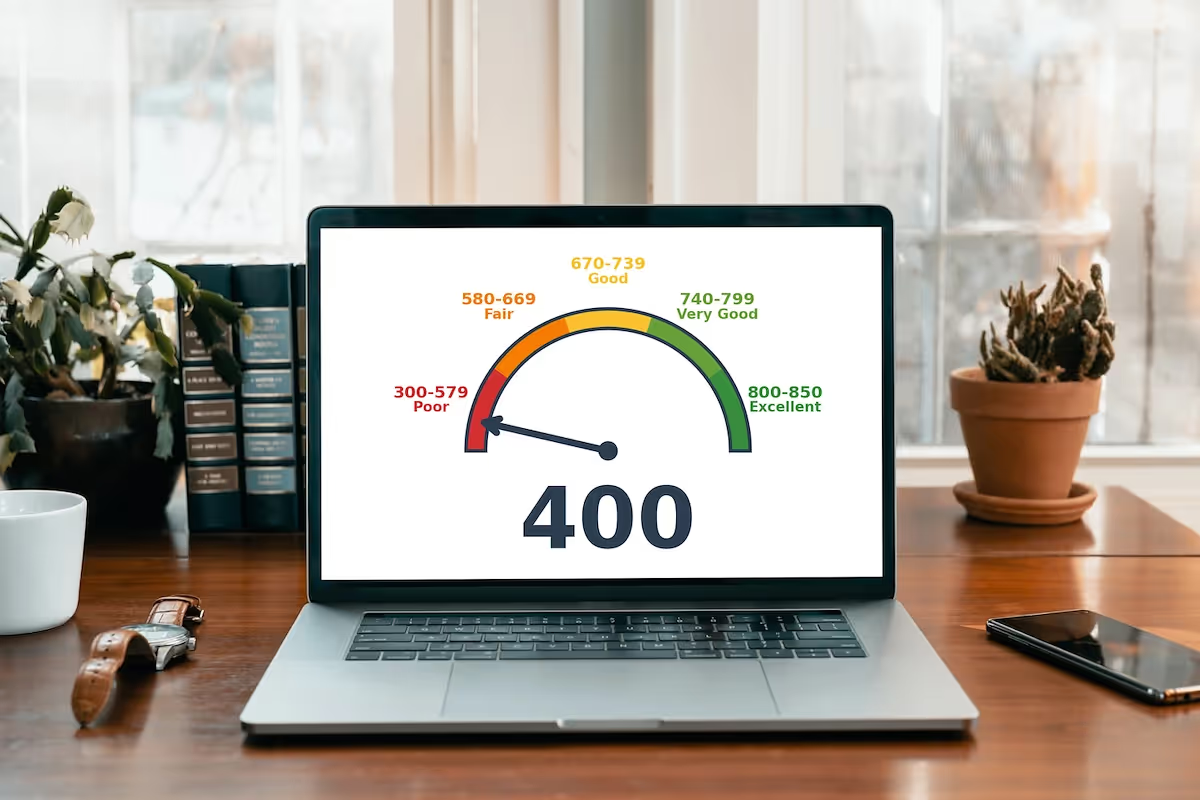
Kudos has partnered with CardRatings and Red Ventures for our coverage of credit card products. Kudos, CardRatings, and Red Ventures may receive a commission from card issuers. Kudos may receive commission from card issuers. Some of the card offers that appear on Kudos are from advertisers and may impact how and where card products appear on the site. Kudos tries to include as many card companies and offers as we are aware of, including offers from issuers that don't pay us, but we may not cover all card companies or all available card offers. You don't have to use our links, but we're grateful when you do!
400 Credit score: What You Need to Know in 2025
July 1, 2025


TL;DR
A 400 credit score provides a foundational starting point for building a stronger financial profile. This score is considered "Poor" by FICO, highlighting a significant opportunity for growth and improvement.
What Does a 400 Credit Score Mean?
A credit score of 400 falls squarely into the "poor" range of FICO scores, which spans from 300 to 579. To lenders, this number signals a very high-risk borrower, making it extremely challenging to qualify for new credit, such as loans or credit cards. If you are approved, you'll likely face steep interest rates and unfavorable terms, significantly increasing the cost of borrowing and impacting your overall financial flexibility.
While a 400 credit score presents considerable financial obstacles, it's important to view it as a starting point, not a permanent label. Understanding the factors that led to this score is the first crucial step on the path toward rebuilding your credit profile. It is possible to move forward and work towards a healthier financial future over time.
Who Has a 400 Credit Score?
While age isn't a direct factor in calculating your credit score, there is a strong correlation between age and creditworthiness. Generally, scores improve as people get older because they have had more time to build a longer credit history and establish a record of on-time payments. According to a 2023 analysis of average credit scores by generation, the breakdown is as follows:
- Generation Z (ages 18-26): 680
- Millennials (ages 27-42): 690
- Generation X (ages 43-58): 709
- Baby Boomers (ages 59-77): 745
- Silent Generation (ages 78+): 760
Credit Cards With a 400 Credit Score
Having a credit score of 400 places you in the 'very poor' credit range, which can significantly hinder your ability to obtain a credit card. Most lenders view a score this low as a major red flag, indicating a high risk of default on payments. Consequently, you'll likely face rejection for most unsecured cards and may only qualify for secured credit cards that require a cash deposit.
Kudos can help you find the right card for your financial situation with its AI-powered Explore Tool, which matches you with options based on your stated preferences and needs. The platform also provides insights into how applying for a new card may impact your credit, helping you make a more informed decision.
Auto Loans and a 400 Credit Score
A 400 credit score places you in the deep subprime category, which can make securing an auto loan challenging. While approval is still possible, you will likely face significantly higher interest rates, making the loan much more expensive over its lifetime.
To put this in perspective, here are the average car loan interest rates by credit score bracket for 2025:
- Super-prime (781-850): 5.25% for new cars and 7.13% for used cars
- Prime (661-780): 6.87% for new cars and 9.36% for used cars
- Non-prime (601-660): 9.83% for new cars and 13.92% for used cars
- Subprime (501-600): 13.18% for new cars and 18.86% for used cars
- Deep subprime (300-500): 15.77% for new cars and 21.55% for used cars
Mortgages at a 400 Credit Score
A 400 credit score is considered very poor, making it extremely difficult to qualify for a home loan. Mainstream mortgage options are generally out of reach; for instance, FHA loans require a minimum score of 500. While some specialty lenders may work with sub-580 borrowers, mortgage options for a 400 score are practically nonexistent with traditional lenders.
If you were to find a rare lender willing to offer a loan, the terms would be highly restrictive. Expect to face the highest possible interest rates and fees to compensate for the lender's risk. You would also need a large down payment—at least 10%—and your application would undergo a much stricter review process than for applicants with higher scores.
What's in a Credit Score?
Figuring out what goes into your credit score can feel like trying to solve a complex puzzle, but it generally boils down to a handful of key elements. The most common factors include:
- Your history of making payments on time is the most significant factor.
- How much of your available credit you're currently using, known as your credit utilization ratio, plays a major role.
- The age of your credit accounts, including the average age and the age of your oldest account, is also considered.
- Lenders like to see that you can responsibly manage different types of credit, such as credit cards and loans.
- Opening several new credit accounts in a short period can be seen as a risk and may temporarily lower your score.
How to Improve Your 400 Credit Score
While a 400 credit score presents challenges, it is absolutely possible to improve it. With consistent, positive financial behavior, most people can see meaningful changes in their score within a few months.
- Monitor your credit reports. You can get free reports from all three major bureaus to check for errors or inaccuracies. Disputing and removing incorrect negative items can provide an immediate boost to a low score.
- Establish automatic bill payments. Your payment history is the single most important factor in your credit score, so making on-time payments is crucial. Setting up automatic payments ensures you never miss a due date, which is the first step to rebuilding your credit.
- Apply for a secured credit card. A secured card is designed for those with damaged credit and can be a great tool for rebuilding. Since it requires a cash deposit, it's easier to get approved, allowing you to build a positive payment history with responsible use.
- Reduce your credit utilization. This ratio measures how much of your available credit you're using, and keeping it low is vital. Even on a secured card with a small limit, making small purchases and paying the balance in full shows lenders you can manage credit responsibly.
The Kudos browser extension can help you manage your cards and monitor your score as you work to improve it.
Unlock your extra benefits when you become a Kudos member

Turn your online shopping into even more rewards

Join over 400,000 members simplifying their finances

Editorial Disclosure: Opinions expressed here are those of Kudos alone, not those of any bank, credit card issuer, hotel, airline, or other entity. This content has not been reviewed, approved or otherwise endorsed by any of the entities included within the post.



































.webp)



.webp)

.webp)


